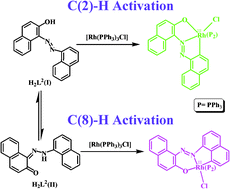C(naphthyl)–H bond activation by rhodium: isolation, characterization and TD-DFT study of the cyclometallates†
Abstract
The C1(naphthyl)–H, C2(naphthyl)–H, C3(naphthyl)–H and C8(naphthyl)–H bonds of the

* Corresponding authors
a
Department of Chemistry, University of North Bengal, Raja Rammohunpur, Siliguri, India
E-mail:
pbchem@rediffmail.com
Fax: 91 353 2699001
Tel: 91 353 2776381
b Department of Chemistry, Missouri S & T, Rolla, MO, USA
The C1(naphthyl)–H, C2(naphthyl)–H, C3(naphthyl)–H and C8(naphthyl)–H bonds of the

 Please wait while we load your content...
Something went wrong. Try again?
Please wait while we load your content...
Something went wrong. Try again?
A. Narayan Biswas, P. Das, S. Sengupta, A. Choudhury and P. Bandyopadhyay, RSC Adv., 2011, 1, 1279 DOI: 10.1039/C1RA00572C
To request permission to reproduce material from this article, please go to the Copyright Clearance Center request page.
If you are an author contributing to an RSC publication, you do not need to request permission provided correct acknowledgement is given.
If you are the author of this article, you do not need to request permission to reproduce figures and diagrams provided correct acknowledgement is given. If you want to reproduce the whole article in a third-party publication (excluding your thesis/dissertation for which permission is not required) please go to the Copyright Clearance Center request page.
Read more about how to correctly acknowledge RSC content.
 Fetching data from CrossRef.
Fetching data from CrossRef.
This may take some time to load.
Loading related content
